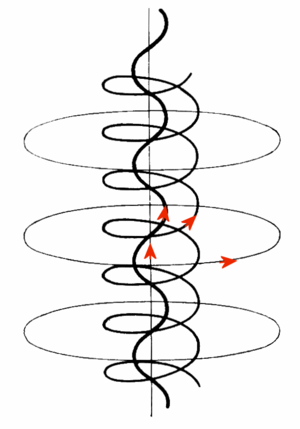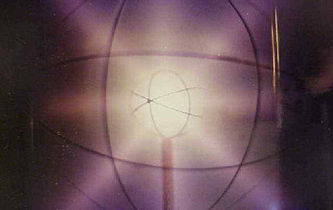
Plasma parameters
Encyclopedia

Plasma (physics)
In physics and chemistry, plasma is a state of matter similar to gas in which a certain portion of the particles are ionized. Heating a gas may ionize its molecules or atoms , thus turning it into a plasma, which contains charged particles: positive ions and negative electrons or ions...
, an electrically conductive collection of charged particle
Charged particle
In physics, a charged particle is a particle with an electric charge. It may be either a subatomic particle or an ion. A collection of charged particles, or even a gas containing a proportion of charged particles, is called a plasma, which is called the fourth state of matter because its...
s that responds collectively to electromagnetic forces. Plasma typically takes the form of neutral gas-like clouds or charged ion beam
Ion beam
An ion beam is a type of charged particle beam consisting of ions. Ion beams have many uses in electronics manufacturing and other industries. A variety of ion beam sources exist, some derived from the mercury vapor thrusters developed by NASA in the 1960s.-Ion beam etching or sputtering:One type...
s, but may also include dust and grains. The behaviour of such particle systems can be studied statistically.
Fundamental plasma parameters
All quantities are in Gaussian cgsCentimetre gram second system of units
The centimetre–gram–second system is a metric system of physical units based on centimetre as the unit of length, gram as a unit of mass, and second as a unit of time...
units except temperature
Temperature
Temperature is a physical property of matter that quantitatively expresses the common notions of hot and cold. Objects of low temperature are cold, while various degrees of higher temperatures are referred to as warm or hot...
expressed in eV and ion mass expressed in units of the proton
Proton
The proton is a subatomic particle with the symbol or and a positive electric charge of 1 elementary charge. One or more protons are present in the nucleus of each atom, along with neutrons. The number of protons in each atom is its atomic number....
mass
 ; Z is charge state; k is Boltzmann's constant; K is wavelength; γ is the adiabatic index; ln Λ is the Coulomb logarithm.
; Z is charge state; k is Boltzmann's constant; K is wavelength; γ is the adiabatic index; ln Λ is the Coulomb logarithm.Frequencies
- electron gyrofrequency, the angular frequency of the circular motion of an electron in the plane perpendicular to the magnetic field:

- ion gyrofrequency, the angular frequency of the circular motion of an ion in the plane perpendicular to the magnetic field:

- electron plasma frequency, the frequency with which electrons oscillate (plasma oscillationPlasma oscillationPlasma oscillations, also known as "Langmuir waves" , are rapid oscillations of the electron density in conducting media such as plasmas or metals. The oscillations can be described as an instability in the dielectric function of a free electron gas. The frequency only depends weakly on the...
):
- ion plasma frequency:

- electron trapping rate:

- ion trapping rate:

- electron collision rate:

- ion collision rate:

Lengths
- Electron thermal de Broglie wavelength, approximate average de Broglie wavelength of electrons in a plasma:

- classical distance of closest approach, the closest that two particles with the elementary charge come to each other if they approach head-on and each have a velocity typical of the temperature, ignoring quantum-mechanical effects:

- electron gyroradius, the radius of the circular motion of an electron in the plane perpendicular to the magnetic field:

- ion gyroradius, the radius of the circular motion of an ion in the plane perpendicular to the magnetic field:

- plasma skin depth, the depth in a plasma to which electromagnetic radiation can penetrate:

- Debye lengthDebye lengthIn plasma physics, the Debye length , named after the Dutch physicist and physical chemist Peter Debye, is the scale over which mobile charge carriers screen out electric fields in plasmas and other conductors. In other words, the Debye length is the distance over which significant charge...
, the scale over which electric fields are screened out by a redistribution of the electrons:
Velocities
- electron thermal velocity, typical velocity of an electron in a Maxwell-Boltzmann distribution:

- ion thermal velocity, typical velocity of an ion in a Maxwell-Boltzmann distribution:

- ion sound velocity, the speed of the longitudinal waves resulting from the mass of the ions and the pressure of the electrons:

- AlfvénHannes AlfvénHannes Olof Gösta Alfvén was a Swedish electrical engineer, plasma physicist and winner of the 1970 Nobel Prize in Physics for his work on magnetohydrodynamics . He described the class of MHD waves now known as Alfvén waves...
velocity, the speed of the wavesAlfvén waveAn Alfvén wave, named after Hannes Alfvén, is a type of magnetohydrodynamic wave.-Definition:An Alfvén wave in a plasma is a low-frequency travelling oscillation of the ions and the magnetic field...
resulting from the mass of the ions and the restoring force of the magnetic field:
Dimensionless

- square root of electron/proton mass ratio

- number of particles in a Debye sphere

- Alfvén velocity/speed of light

- electron plasma/gyrofrequency ratio

- ion plasma/gyrofrequency ratio

- thermal/magnetic pressure ratio ("betaBeta (plasma physics)The beta of a plasma, symbolized by β, is the ratio of the plasma pressure to the magnetic pressure...
")
- magnetic/ion rest energy ratio


